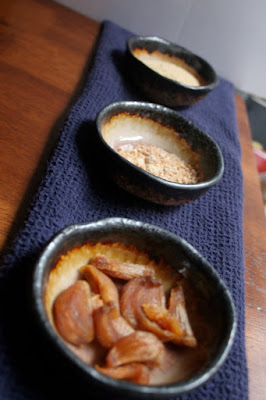Roasted Garlic Powder: Perfect For Sous Vide Cooking
I have always used garlic powder. I am pretty heavy handed with it. It used to be my salt. After starting to cook sous vide, that love has been rekindled. This is because most advice around sous vide discourages the use of fresh garlic. According to baldwind:
"Finally, raw garlic produces very pronounced and unpleasant results and powdered garlic (in very small quantities) should be substituted."
After reading that, I set out to make garlic powder. It is ridiculously simple, and like all things culinary, when you can control it, you can make it better. In this case, you have three major wins:
- Before you begin making garlic powder, you can control the quality of the garlic. Like most spices you buy, it is hard to determine original quality and how long it has been deteriorating on a grocery shelf or storeroom.
- Roasting. You can bring the noise by roasting the garlic. When you compare the aroma and flavor of your homemade roasted garlic to whatever you have been buying at the piggly wiggly, you will start using your old garlic powder to soak up paint and oil spills (see sawdust uses).
- Finally, you can also choose how finely ground you want to grind the garlic, letting you control the speed of absorption and flavor release.
Making roasted garlic powder is unbelievably simple:
- Start with four (4) heads of awesome, fresh garlic. Again, this is one of the huge wins of doing this yourself. Don't f*ck around.
- Roast them. Use your favorite recipe. Or google it. Really its wrapping the heads in foil, possibly slicing the top off and drizzling olive oil. Just add heat and time. I use 350F. Garlic should be soft and a caramel color on the outside.
- Squeeze it out. I try to keep it all whole just because it is easier to deal with. This part tends to take me the most amount of active time.
- If you used olive oil, place them on some towels. The goal here is to try and absorb some of the oil on the surface of the garlic. Keeping them whole makes this step way easier.
- Dehydrate. You can use your oven on its lowest setting or a dehydrator. The dehydrator takes like a day or maybe longer. Usually at some point, I chop up the whole garlic cloves to increase the exposed garlic surface area so that dehydration happens faster.
- Grind to your desired fineness. Sometimes after I do this step it doesn't feel dry enough. If it still feels wet, GOTO 5.




Personaly, i dont like garlic powder, it tastes great, but the benefits are missing, not like the raw one. Thanks for the explanations.
ReplyDeleteI just got a Sous Vide Demi and am dying to try this out. Do you use a dedicated grinder? Might I be able to do it with my Mexican molcajete? (Stone mortar and pestle.)
ReplyDelete@Craig:
ReplyDeleteI used a dedicated grinder. While I think its possible to do with a molcajete, I'm hesitant to recommend it. If you do use it, i'd also recommend running the end result through a strainer to get out bigger pieces (and then try grinding those up again).
If you go this route, let us know how it goes!
I ended up getting a Krupps coffee grinder, as Cook's Illustrated said it was the best spice grinder. I think my powder turned out really well, but there are some parts that didn't go as expected.
ReplyDeleteI chose not to drizzle any oil. I just lopped the tops off, wrapped them in foil, and gave them an hour at 350. When it came time to squeeze out the garlic it was like extruding garlic toothpaste. No whole cloves came out at all. Perhaps I didn't lop off enough of the top?
I put cheesecloth on the perforated tray that comes with my Gaggenau oven, set it at 130 dry, and let it go about a day. It dried pretty well, although the bigger pieces were a tad gummy, and much of it remained firmly glued to the cheesecloth.
As I ground it I kept passing it through a strainer to separate the fine powder, and re-ground the larger chunks. Then I spread the result on a pan and dried it another hour at 135 for good measure.
All in all a success, but I lost a fair amount to the cheesecloth. I'm open to suggestions.
Thanks for the recipe! I'm looking forward to cooking with this stuff.
Craig I know way old thread but I was using google and it showed up. So I figured I should comment on the cheese cloth thing I used that the first time I dryed roasted garlic big mistake use parchment paper works great . I roast for 1 hour at 350 let cool squeeze out the garlic then mash and spread out onto parchment paper dry until brittle grind sift the bigger chunks I regrind and sift again anything left after that I toss.
ReplyDeleteParchment paper makes much more sense. And this may set a record for the longest gap between comment and reply! Thanks.
ReplyDelete8.5 yrs after your original post, I have to ask, have you tried the parchment? It works great!
DeleteThat was awesome. Just awesome!
ReplyDelete